Surface Temperature Trend Estimation over 12 Sites in Guinea Using 57 Years of Ground-Based Data
Abstract
1. Introduction
2. Materials and Methods
2.1. Study Site Description
2.2. Data
2.2.1. Ground-based Data
2.2.2. MERRA 2 Model Data
2.2.3. Climate Forcings
2.3. Methods
2.3.1. Trend-Run Model
2.3.2. Mann-Kendall Tests
3. Results
3.1. Climatology of Temperature
Annual and Inter-Annual Variation of Temperature
3.2. Trends Estimation
3.2.1. Temporal Evolution of Temperature and Simulation from the Trend-Run Model
3.2.2. Contribution of Climate Forcings
3.2.3. Trend Estimation by MK and SQ-MK
3.3. Spatial Analysis
4. Discussion
5. Conclusions
Author Contributions
Funding
Acknowledgments
Conflicts of Interest
Appendix A


References
- Wang, J.; Xu, C.; Hu, M.; Li, Q.; Yan, Z.; Jones, P. Global land surface air temperature dynamics since 1880. Int. J. Climatol. 2017, 38, e466–e474. [Google Scholar] [CrossRef]
- IPCC Special Report on the Impacts of Global Warming of 1.5 °C above Pre-Industrial Levels and Related Global Greenhouse Gas Emission Pathways, in the Context of Strengthening the Global Response to the Threat of Climate Change, Sustainable Development, and Efforts to Eradicate Poverty 2018. Available online: https://www.ipcc.ch/site/assets/uploads/sites/2/2019/06/SR15_Full_Report_High_Res.pdf (accessed on 29 May 2020).
- Conway, D. Adapting climate research for development in Africa. Wiley Interdiscip. Rev. Clim. Chang. 2011, 2, 428–450. [Google Scholar] [CrossRef]
- Prein, A.F.; Langhans, W.; Fosser, G.; Ferrone, A.; Ban, N.; Goergen, K.; Keller, M.; Tölle, M.; Gutjahr, O.; Feser, F.; et al. A review on regional convection-permitting climate modeling: Demonstrations, prospects, and challenges. Rev. Geophys. 2015, 53, 323–361. [Google Scholar] [CrossRef]
- Simmons, A.J.; Berrisford, P.; Dee, D.P.; Hersbach, H.; Hirahara, S.; Thépaut, J.-N. A reassessment of temperature variations and trends from global reanalyses and monthly surface climatological datasets. Q. J. R. Meteorol. Soc. 2016, 143, 101–119. [Google Scholar] [CrossRef]
- Diba, I.; Camara, M.; Sarr, A.; Diedhiou, A. Potential Impacts of Land Cover Change on the Interannual Variability of Rainfall and Surface Temperature over West Africa. Atmosphere 2018, 9, 376. [Google Scholar] [CrossRef]
- Barry, A.A.; Caesar, J.; Tank, A.M.G.K.; Aguilar, E.; McSweeney, C.; Cyrille, A.M.; Nikiema, M.P.; Narcisse, K.B.; Sima, F.; Stafford, G.; et al. West Africa climate extremes and climate change indices. Int. J. Climatol. 2018, 38, e921–e938. [Google Scholar] [CrossRef]
- Masih, I.; Maskey, S.; Mussá, F.E.F.; Trambauer, P. A review of droughts on the African continent: A geospatial and long-term perspective. Hydrol. Earth Syst. Sci. 2014, 18, 3635–3649. [Google Scholar] [CrossRef]
- Nicholson, S.E.; Some, B.; Kone, B. An Analysis of Recent Rainfall Conditions in West Africa, Including the Rainy Seasons of the 1997 El Niño and the 1998 La Niña Years. J. Clim. 2000, 13, 2628–2640. [Google Scholar] [CrossRef]
- Jimmy, R.; Govender, P.; Bencherif, H.; Moodley, M. TREND-RUN model application of surface temperature and its implications for South African forestry and reforestation using local weather services data. Reforesta 2019, 50–72. [Google Scholar] [CrossRef]
- Barké, K.; Salifou, M. Analyse des phénomènes climatiques extrêmes dans le sud-est du Niger. Publ. Assoc. Int. Climatol. 2015, 28, 537–542. [Google Scholar]
- Bègue, N.; Bencherif, H.; Sivakumar, V.; Kirgis, G.; Mze, N.; Leclair de Bellevue, J. Temperature variability and trends in the UT-LS over a subtropical site: Reunion (20.8° S, 55.5° E). Atmos. Chem. Phys. 2010, 10, 8563–8574. [Google Scholar] [CrossRef]
- Bègue, N.; Mbatha, N.; Bencherif, H.; Loua, R.T.; Sivakumar, V.; Leblanc, T. Statistical analysis of the mesospheric inversion layers over two symmetrical tropical sites: Réunion (20.8° S, 55.5° E) and Mauna Loa (19.5° N, 155.6° W). Ann. Geophys. 2017, 35, 1177–1194. [Google Scholar] [CrossRef][Green Version]
- Bencherif, H.; Diab, R.D.; Portafaix, T.; Morel, B.; Keckhut, P.; Moorgawa, A. Temperature climatology and trend estimates in the UTLS region as observed over a southern subtropical site, Durban, South Africa. Atmos. Chem. Phys. 2006, 6, 5121–5128. [Google Scholar] [CrossRef]
- Fontaine, B.; Janicot, S. Sea Surface Temperature Fields Associated with West African Rainfall Anomaly Types. J. Clim. 1996, 9, 2935–2940. [Google Scholar] [CrossRef]
- Foster, G.; Rahmstorf, S. Global temperature evolution 1979–2010. Environ. Res. Lett. 2011, 7, 044022. [Google Scholar] [CrossRef]
- Kouassi, A.; Assamoi, P.; Bigot, S.; Diawara, A.; Schayes, G.; Yoroba, F.; Kouassi, B. Étude du climat ouest-africain à l’aide du modèle atmosphérique régional M.A.R. Climatologie 2010, 7, 39–55. [Google Scholar] [CrossRef][Green Version]
- Loua, R.T.; Beavogui, M.; Bencherif, H.; Bamba, Z.; Amory-Mazaudier, C. Climatology of Guinea: Study of Climate Variability in N’zerekore. J. Agric. Sci. Technol. A 2017, 7, 115–223. [Google Scholar]
- Loua, R.T.; Bencherif, H.; Mbatha, N.; Bègue, N.; Hauchecorne, A.; Bamba, Z.; Sivakumar, V. Study on Temporal Variations of Surface Temperature and Rainfall at Conakry Airport, Guinea: 1960–2016. Climate 2019, 7, 93. [Google Scholar] [CrossRef]
- Serra, C.; Burgueño, A.; Lana, X. Analysis of maximum and minimum daily temperatures recorded at Fabra Observatory (Barcelona, NE Spain) in the period 1917–1998. Int. J. Climatol. 2001, 21, 617–636. [Google Scholar] [CrossRef]
- Škerlak, B.; Sprenger, M.; Wernli, H. A global climatology of stratosphere–troposphere exchange using the ERA-Interim data set from 1979 to 2011. Atmos. Chem. Phys. 2014, 14, 913–937. [Google Scholar] [CrossRef]
- Zebiak, S.E. Air–Sea Interaction in the Equatorial Atlantic Region. J. Clim. 1993, 6, 1567–1586. [Google Scholar] [CrossRef]
- Ahmed, S.I.; Rudra, R.; Dickinson, T.; Ahmed, M. Trend and Periodicity of Temperature Time Series in Ontario. Am. J. Clim. Chang. 2014, 3, 272–288. [Google Scholar] [CrossRef]
- Esterby, S.R. Review of methods for the detection and estimation of trends with emphasis on water quality applications. Hydrol. Process. 1996, 10, 127–149. [Google Scholar] [CrossRef]
- Zarenistanak, M.; Dhorde, A.G.; Kripalani, R.H. Trend analysis and change point detection of annual and seasonal precipitation and temperature series over southwest Iran. J. Earth Syst. Sci. 2014, 123, 281–295. [Google Scholar] [CrossRef]
- Mann, H.B. Nonparametric Tests against Trend. Econometrica 1945, 13, 245–259. [Google Scholar] [CrossRef]
- Kendall, M.G. Rank Correlation Methods; Charles Griffin Co Ltd.: Oxford, UK, 1948; p. 60. [Google Scholar]
- Galton, F. Regression towards Mediocrity in Hereditary Stature. J. Anthropol. Inst. Great Br. Irel. 1886, 15, 246–263. [Google Scholar] [CrossRef]
- Bulmer, M. Galton’s law of ancestral heredity. Heredity 1998, 81, 579–585. [Google Scholar] [CrossRef]
- Joshi, M.K.; Pandey, A.C. Trend and spectral analysis of rainfall over India during 1901–2000. J. Geophys. Res. Atmos. 2011, 116. [Google Scholar] [CrossRef]
- Mbatha, N.; Xulu, S. Time Series Analysis of MODIS-Derived NDVI for the Hluhluwe-Imfolozi Park, South Africa: Impact of Recent Intense Drought. Climate 2018, 6, 95. [Google Scholar] [CrossRef]
- Chen, C.J.; Chen, C.C.; Lo, M.H.; Juang, J.Y.; Chang, C.M. Central Taiwan’s hydroclimate in response to land use/cover change. Environ. Res. Lett. 2020, 15, 034015. [Google Scholar] [CrossRef]
- Mahmood, R.; Pielke Sr, R.A.; Hubbard, K.G.; Niyogi, D.; Dirmeyer, P.A.; McAlpine, C.; Carleton, A.M.; Hale, R.; Gameda, S.; Beltrán-Przekurat, A.; et al. Land cover changes and their biogeophysical effects on climate. Int. J. Climatol. 2014, 34, 929–953. [Google Scholar] [CrossRef]
- He, Y.; Lee, E.; Mankin, J.S. Seasonal tropospheric cooling in Northeast China associated with cropland expansion. Environ. Res. Lett. 2019, 15, 034032. [Google Scholar] [CrossRef]
- Pearson, K. Determination of the Coefficient of Correlation. Science 1909, 30, 23–25. [Google Scholar] [CrossRef]
- Xie, S.-P.; Tanimoto, Y.; Noguchi, H.; Matsuno, T. How and why climate variability differs between the tropical Atlantic and Pacific. Geophys. Res. Lett. 1999, 26, 1609–1612. [Google Scholar] [CrossRef]
- Cabos, W.; de la Vara, A.; Koseki, S. Tropical Atlantic Variability: Observations and Modeling. Atmosphere 2019, 10, 502. [Google Scholar] [CrossRef]
- Carton, J.A.; Cao, X.; Giese, B.S.; Da Silva, A.M. Decadal and Interannual SST Variability in the Tropical Atlantic Ocean. J. Phys. Oceanogr. 1996, 26, 1165–1175. [Google Scholar] [CrossRef]
- Huang, B.; Carton, J.A.; Shukla, J. A Numerical Simulation of the Variability in the Tropical Atlantic Ocean, 1980–1988; American Meteorlogical Sociey: Massachusetts, MA, USA, 1995; pp. 835–854. [Google Scholar]
- Enfield, D.B. Relationships of inter-American rainfall to tropical Atlantic and Pacific SST variability. Geophys. Res. Lett. 1996, 23, 3305–3308. [Google Scholar] [CrossRef]
- Enfield, D.B.; Mestas-Nuñez, A.M.; Mayer, D.A.; Cid-Serrano, L. How ubiquitous is the dipole relationship in tropical Atlantic sea surface temperatures? J. Geophys. Res. Oceans 1999, 104, 7841–7848. [Google Scholar] [CrossRef]
- Servain, J.; Wainer, I.; McCreary, J.P.; Dessier, A. Relationship between the equatorial and meridional modes of climatic variability in the tropical Atlantic. Geophys. Res. Lett. 1999, 26, 485–488. [Google Scholar] [CrossRef]
- Vimont, D.J.; Kossin, J.P. The Atlantic Meridional Mode and hurricane activity. Geophys. Res. Lett. 2007, 34. [Google Scholar] [CrossRef]
- Kossin, J.P.; Vimont, D.J. A More General Framework for Understanding Atlantic Hurricane Variability and Trends. Bull. Am. Meteorol. Soc. 2007, 88, 1767–1782. [Google Scholar] [CrossRef]
- Chiang, J.C.H.; Vimont, D.J. Analogous Pacific and Atlantic Meridional Modes of Tropical Atmosphere—Ocean Variability. J. Clim. 2004, 17, 4143–4158. [Google Scholar] [CrossRef]
- Amaya, D.J.; DeFlorio, M.J.; Miller, A.J.; Xie, S.-P. WES feedback and the Atlantic Meridional Mode: Observations and CMIP5 comparisons. Clim. Dyn. 2017, 49, 1665–1679. [Google Scholar] [CrossRef]
- Wang, C. ENSO, Atlantic Climate Variability, and the Walker and Hadley Circulations. In The Hadley Circulation: Present, Past and Future; Diaz, H.F., Bradley, R.S., Eds.; Springer: Dordrecht, The Netherlands, 2005; Volume 21, pp. 173–202. ISBN 978-90-481-6752-4. [Google Scholar]
- Brierley, C.; Wainer, I. Inter-annual variability in the tropical Atlantic from the Last Glacial Maximum into future climate projections simulated by CMIP5/PMIP3. Clim. Past 2018, 14, 1377–1390. [Google Scholar] [CrossRef]
- Xie, S.-P.; Carton, J.A. Tropical Atlantic Variability: Patterns, Mechanisms, and Impacts. In Geophysical Monograph Series; Wang, C., Xie, S.P., Carton, J.A., Eds.; American Geophysical Union: Washington, DC, USA, 2004; pp. 121–142. ISBN 978-1-118-66594-7. [Google Scholar]
- Rodríguez-Fonseca, B.; Mohino, E.; Mechoso, C.R.; Caminade, C.; Biasutti, M.; Gaetani, M.; Garcia-Serrano, J.; Vizy, E.K.; Cook, K.; Xue, Y.; et al. Variability and Predictability of West African Droughts: A Review on the Role of Sea Surface Temperature Anomalies. J. Clim. 2015, 28, 4034–4060. [Google Scholar] [CrossRef]
- Trenberth, K. Niño SST Indices (Niño 1 + 2, 3, 3.4, 4; ONI and TNI)|NCAR—Climate Data Guide. Available online: https://climatedataguide.ucar.edu/climate-data/nino-sst-indices-nino-12-3-34-4-oni-and-tni (accessed on 13 December 2019).
- Zerbo, J.-L.; Ouattara, F.; Nanéma, E. Solar Activity and Meteorological Fluctuations in West Africa: Temperatures and Pluviometry in Burkina Faso, 1970–2012. Int. J. Astron. Astrophys. 2013, 3, 408–411. [Google Scholar] [CrossRef][Green Version]
- Baker, D.N. Effects of the Sun on the Earth’s environment. J. Atmos. Sol. Terr. Phys. 2000, 62, 1669–1681. [Google Scholar] [CrossRef]
- van Loon, H.; Meehl, G.A. Interactions between externally forced climate signals from sunspot peaks and the internally generated Pacific Decadal and North Atlantic Oscillations. Geophys. Res. Lett. 2014, 41, 161–166. [Google Scholar] [CrossRef]
- Li, K.J.; Gao, P.X.; Zhan, L.S. Synchronization of Hemispheric Sunspot Activity Revisited: Wavelet Transform Analyses. Astrophys. J. 2009, 691, 537. [Google Scholar] [CrossRef]
- Hauchecorne, A.; Chanin, M.-L.; Keckhut, P. Climatology and trends of the middle atmospheric temperature (33–87 km) as seen by Rayleigh lidar over the south of France. J. Geophys. Res. Atmos. 1991, 96, 15297–15309. [Google Scholar] [CrossRef]
- Keckhut, P.; Hauchecorne, A.; Chanin, M.L. Midlatitude long-term variability of the middle atmosphere: Trends and cyclic and episodic changes. J. Geophys. Res. Atmos. 1995, 100, 18887–18897. [Google Scholar] [CrossRef]
- Guirlet, M.; Keckhut, P.; Godin, S.; Megie, G. Description of the long-term ozone data series obtained from different instrumental techniques at a single location: The Observatoire de Haute-Provence (43.9° N, 5.7° E). Ann. Geophys. 2000, 18, 1325–1339. [Google Scholar] [CrossRef]
- Sivakumar, V.; Jimmy, R.; Bencherif, H.; Bègue, N.; Portafaix, T. Use of the TREND RUN model to deduce trends in South African Weather Service (SAWS) atmospheric data: Case study over Addo (33.568° S, 25.692° E) Eastern Cape, South Africa. J. Neutral Atmos. 2017, 51–58. [Google Scholar]
- Toihir, A.M.; Portafaix, T.; Sivakumar, V.; Bencherif, H.; Pazmiño, A.; Bègue, N. Variability and trend in ozone over the southern tropics and subtropics. Ann. Geophys. 2018, 36, 381–404. [Google Scholar] [CrossRef]
- Sivakumar, V.; Jimmy, R.; Bencherif, H.; Begue, N.; Portfaix, T. TREND RUN model for performing the trend calculation on SAWS (South African Weather Service) atmospheric data: A case study over ADDO (33.568 S; 25.692 E) Cape-Town. J. Neut. Atmos. 2017, 1, 43–51. [Google Scholar]
- Kendall, M.G. Rank Correlation Methods; Griffin: London, UK, 1975; ISBN 978-0-85264-199-6. [Google Scholar]
- Gilbert, R.O. Statistical Methods for Environmental Pollution Monitoring; Pacific Northwest National Lab (PNNL): Richland, WA, USA, 1987. [Google Scholar]
- Hirsch, R.; Slack, J.; Smith, R. Techniques of Trend Analysis for Monthly Water Quality Data. Water Resour. Res. 1982, 18, 107–121. [Google Scholar] [CrossRef]
- WMO World Climate Applications Programme (WCAP). Analyzing Long Time Series of Hydrological Data with Respect to Climate Variability: Project Description; WMO/TD; WMO: Geneva, Switzerland, 1988; No. 03. [Google Scholar]
- Sharma, S.; Singh, P.K. Spatial trends in rainfall seasonality: A case study in Jharkhand, India. Weather 2019, 74, 31–39. [Google Scholar] [CrossRef]
- Pal, I.; Al-Tabbaa, A. Trends in seasonal precipitation extremes—An indicator of ‘climate change’ in Kerala, India. J. Hydrol. 2009, 367, 62–69. [Google Scholar] [CrossRef]
- Sneyers, R. On the Statistical Analysis of Series of Bbservations; Technical Note No°.143; Secretariat of the World Meteorological Organisation: Geneva, Switzerland, 1990; ISBN 978-92-63-10415-1. [Google Scholar]
- Cook, K.H. Generation of the African Easterly Jet and Its Role in Determining West African Precipitation. J. Clim. 1999, 12, 1165–1184. [Google Scholar] [CrossRef]
- Torrence, C.; Compo, G.P. A Practical Guide to Wavelet Analysis. Bull. Am. Meteorol. Soc. 1998, 79, 61–78. [Google Scholar] [CrossRef]
- Bultheel, A. Learning to swim in a sea of wavelets. Bull. Belg. Math. Soc. 1995, 2, 1–45. [Google Scholar] [CrossRef]
- Chang, S.G.; Yu, B.; Vetterli, M. Adaptive wavelet thresholding for image denoising and compression. IEEE Trans. Image Process. 2000, 9, 1532–1546. [Google Scholar] [CrossRef]
- WMO: World Meteorological Organization: Climate Data and Monitoring. In Proceedings of the Ninth Seminar for Homogenization and Quality Control in Climatological Databases and Fourth Conference on Spatial Interpolation Techniques in Climatology and Meteorology, Budapest, Hungary, 3–7 April 2017; Report No. 82. World Meteorological Organization (WMO): Genève, Switzerland, 2017.
- Jones, P.D.; Parker, D.E.; Osborn, T.J.; Briffa, K.R. Global and Hemispheric Temperature Anomalies: Land and Marine Instrumental Records (1850–2015). Available online: https://www.osti.gov/biblio/1389299 (accessed on 29 May 2020).
- Salama, M.S.; Van der Velde, R.; Zhong, L.; Ma, Y.; Ofwono, M.; Su, Z. Decadal variations of land surface temperature anomalies observed over the Tibetan Plateau by the Special Sensor Microwave Imager (SSM/I) from 1987 to 2008. Clim. Chang. 2012, 114, 769–781. [Google Scholar] [CrossRef]
- Spear, S.F.; Groves, J.D.; Williams, L.A.; Waits, L.P. Using environmental DNA methods to improve detectability in a hellbender (Cryptobranchus alleganiensis) monitoring program. Biol. Conserv. 2015, 183, 38–45. [Google Scholar] [CrossRef]
- Huang, F.T.; Mayr, H.G.; Reber, C.A.; Russell, J.M.; Mlynczak, M.; Mengel, J.G. Stratospheric and mesospheric temperature variations for the quasi-biennial and semiannual (QBO and SAO) oscillations based on measurements from SABER (TIMED) and MLS (UARS). Ann. Geophys. 2006, 24, 2131–2149. [Google Scholar] [CrossRef]
- Remsberg, E.; Deaver, L.; Wells, J.; Lingenfelser, G.; Bhatt, P.; Gordley, L.; Thompson, R.; McHugh, M.; Russell, J.M., III; Keckhut, P.; et al. An assessment of the quality of Halogen Occultation Experiment temperature profiles in the mesosphere based on comparisons with Rayleigh backscatter lidar and inflatable falling sphere measurements. J. Geophys. Res. 2002, 107, ACL13-1–ACL13-9. [Google Scholar] [CrossRef]
- Vose, R.S.; Arndt, D.; Banzon, V.F.; Easterling, D.R.; Gleason, B.; Huang, B.; Kearns, E.; Lawrimore, J.H.; Menne, M.J.; Peterson, T.C.; et al. NOAA’s Merged Land–Ocean Surface Temperature Analysis. Bull. Am. Meteorol. Soc. 2012, 93, 1677–1685. [Google Scholar] [CrossRef]
- Ringard, J.; Dieppois, B.; Rome, S.; Diedhiou, A.; Pellarin, T.; Konaré, A.; Diawara, A.; Konaté, D.; Dje, B.K.; Katiellou, G.L.; et al. The intensification of thermal extremes in west Africa. Glob. Planet. Chang. 2016, C, 66–77. [Google Scholar] [CrossRef]
- Rome, S.; Caniaux, G.; Ringard, J.; Dieppois, B.; Diedhiou, A. Identification de tendances récentes et ruptures d’homogénéité des températures: Exemple en Afrique de l’Ouest et sur le Golfe de Guinée; Publications de l’Association Internationale de Climatologie: Liège, Belgium, 2015; p. 7. [Google Scholar]
- Hamed, K.H.; Ramachandra Rao, A. A modified Mann-Kendall trend test for autocorrelated data. J. Hydrol. 1998, 204, 182–196. [Google Scholar] [CrossRef]
- PANA Plan d’Action National d’Adaptation aux Changements Climatiques de le République de Guinée. Available online: https://unfccc.int/resource/docs/napa/gin01f.pdf (accessed on 29 May 2020).
- Rahman, M.A.; Yunsheng, L.; Sultana, N. Analysis and prediction of rainfall trends over Bangladesh using Mann–Kendall, Spearman’s rho tests and ARIMA model. Meteorol. Atmos. Phys. 2017, 129, 409–424. [Google Scholar] [CrossRef]
- Sarr, B. Present and future climate change in the semi-arid region of West Africa: A crucial input for practical adaptation in agriculture. Atmos. Sci. Lett. 2012, 13, 108–112. [Google Scholar] [CrossRef]
- Pettorelli, N.; Vik, J.O.; Mysterud, A.; Gaillard, J.-M.; Tucker, C.J.; Stenseth, N.S. Using the satellite-derived NDVI to assess ecological responses to environmental change. Trends Ecol. Evol. 2005, 20, 503–510. [Google Scholar] [CrossRef]
- Wang, J.; Rich, P.M.; Price, K.P. Temporal responses of NDVI to precipitation and temperature in the central Great Plains, USA. Int. J. Remote Sens. 2010, 24, 2345–2364. [Google Scholar] [CrossRef]
- Szilagyi, J.; Franz, T.E. Anthropogenic hydrometeorological changes at a regional scale: Observed irrigation—Precipitation feedback (1979–2015) in Nebraska, USA. Sustain. Water Resour. Manag. 2020, 6. [Google Scholar] [CrossRef]
- Pielke, R.A.; Davey, C.A.; Niyogi, D.; Fall, S.; Steinweg-Woods, J.; Hubbard, K.; Lin, X.; Cai, M.; Lim, Y.-K.; Li, H.; et al. Unresolved issues with the assessment of multidecadal global land surface temperature trends. J. Geophys. Res. 2007, 112. [Google Scholar] [CrossRef]
- Du, J.; Wang, K.; Wang, J.; Ma, Q. Contributions of surface solar radiation and precipitation to the spatiotemporal patterns of surface and air warming in China from 1960 to 2003. Atmos. Chem. Phys. 2017, 17, 4931–4944. [Google Scholar] [CrossRef]
- Neumann, R.; Jung, G.; Laux, P.; Kunstmann, H. Climate trends of temperature, precipitation and river discharge in the Volta Basin of West Africa. Int. J. River Basin Manag. 2007, 5, 17–30. [Google Scholar] [CrossRef]
- Christidis, N.; Stott, P.A.; Brown, S.; Hegerl, G.C.; Caesar, J. Detection of changes in temperature extremes during the second half of the 20th century. Geophys. Res. Lett. 2005, 32. [Google Scholar] [CrossRef]
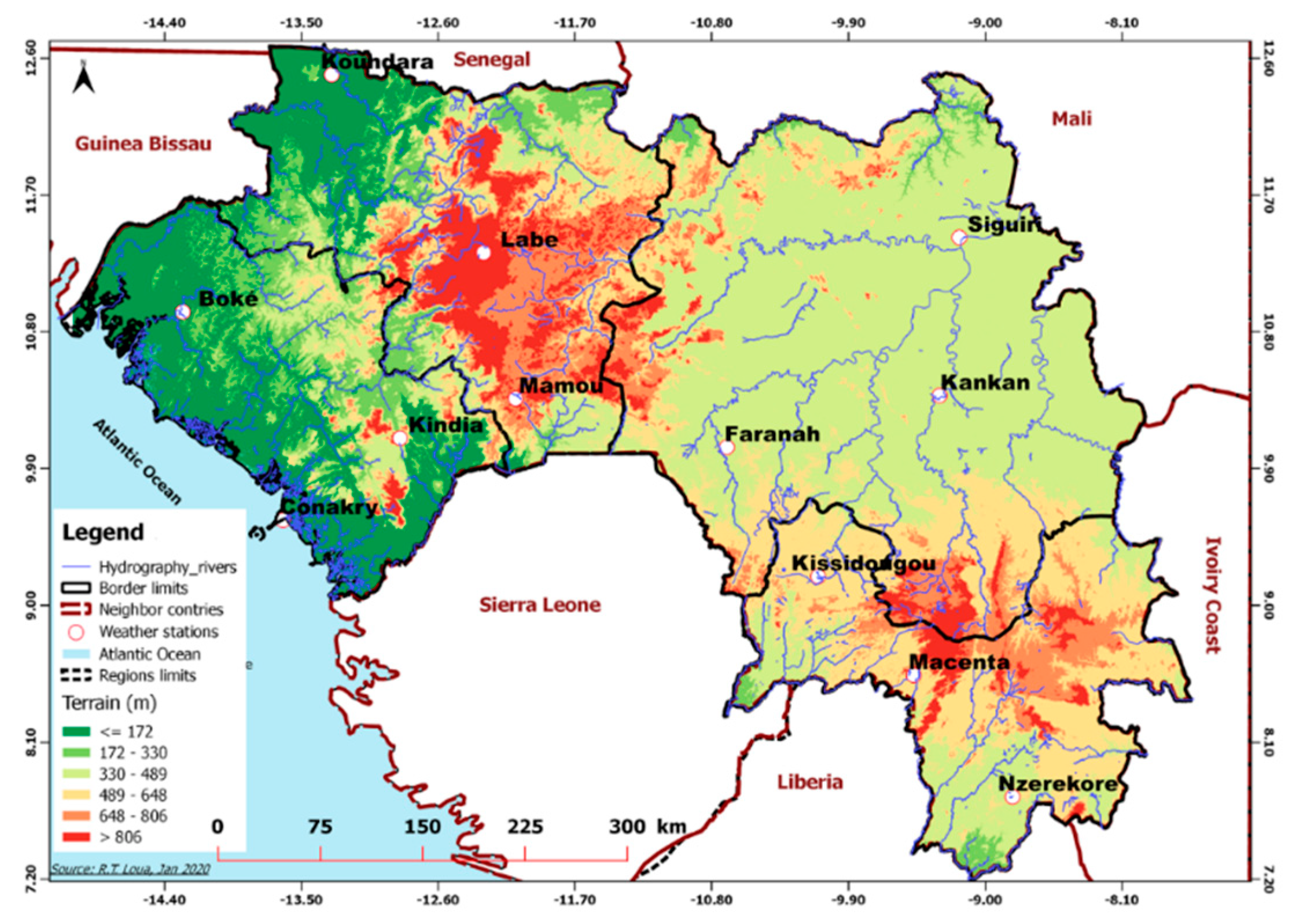
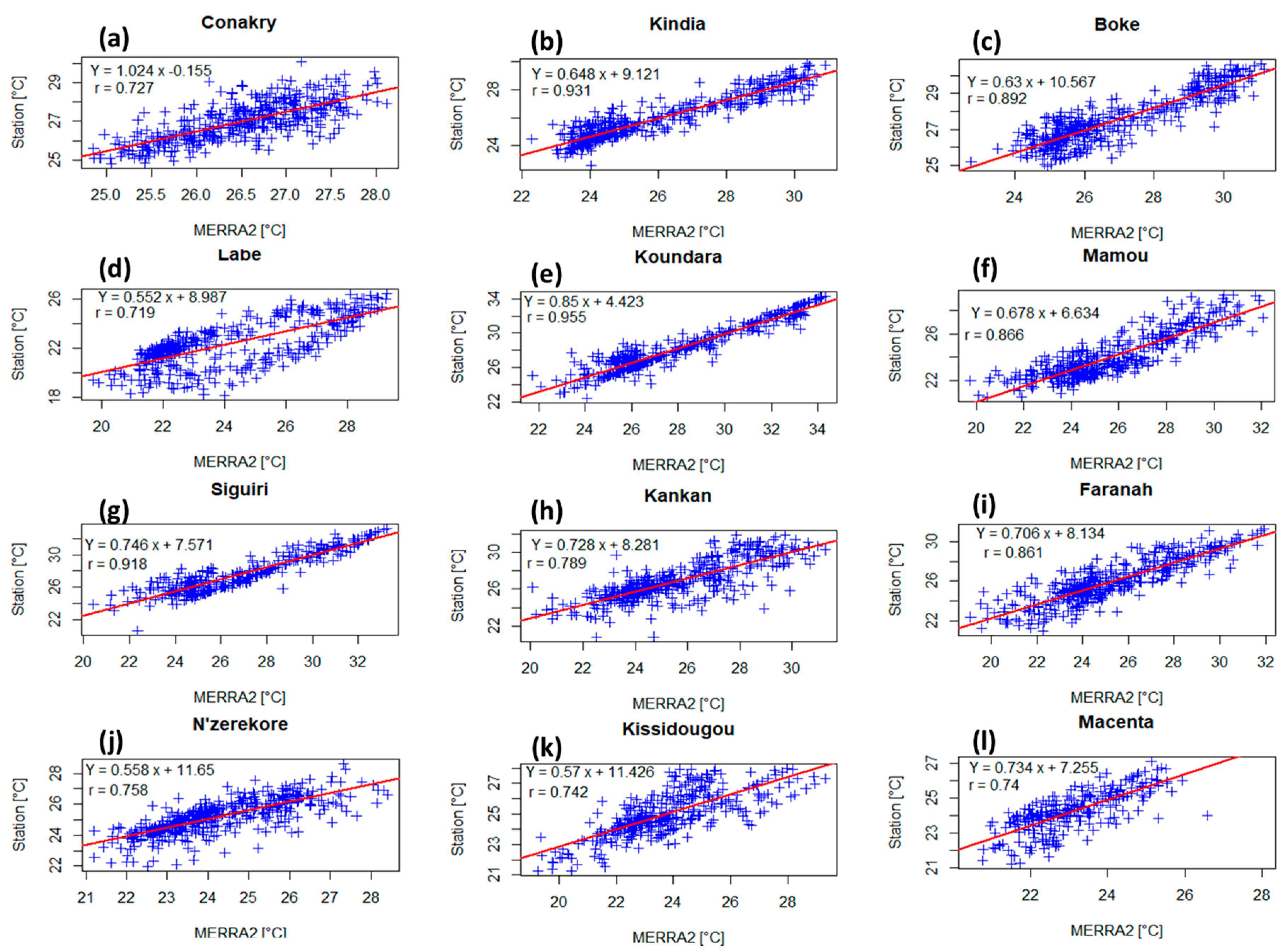
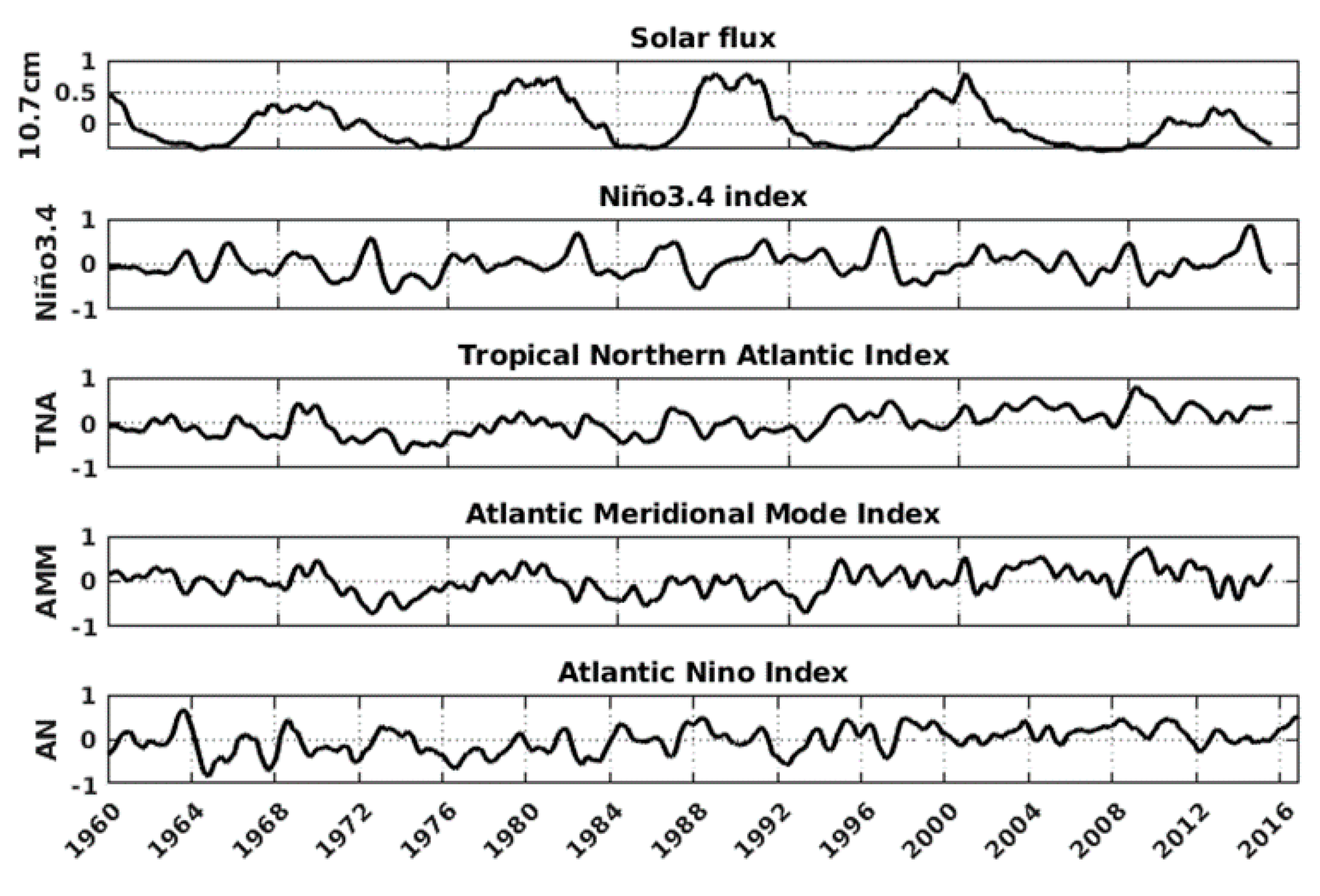
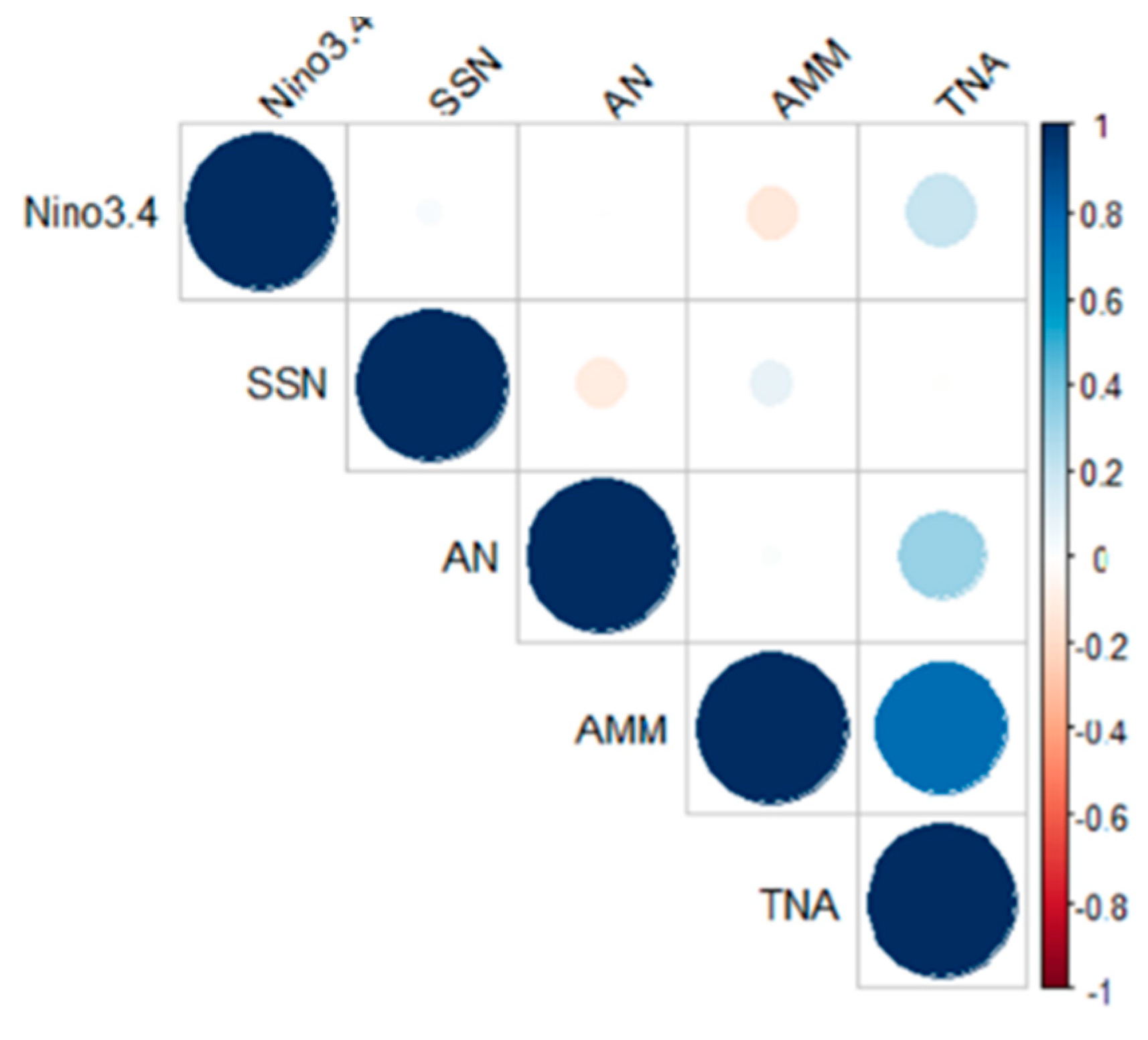
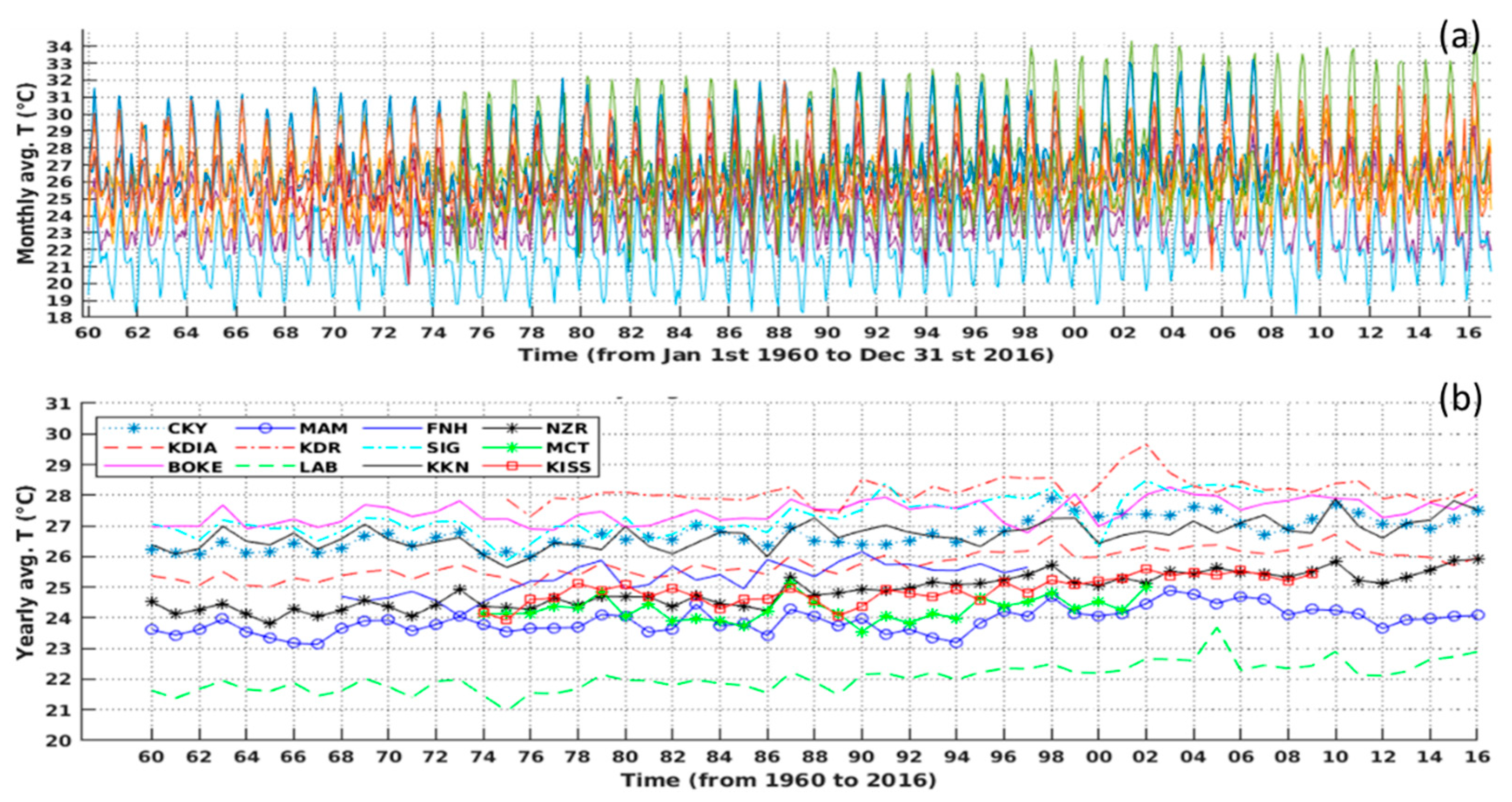



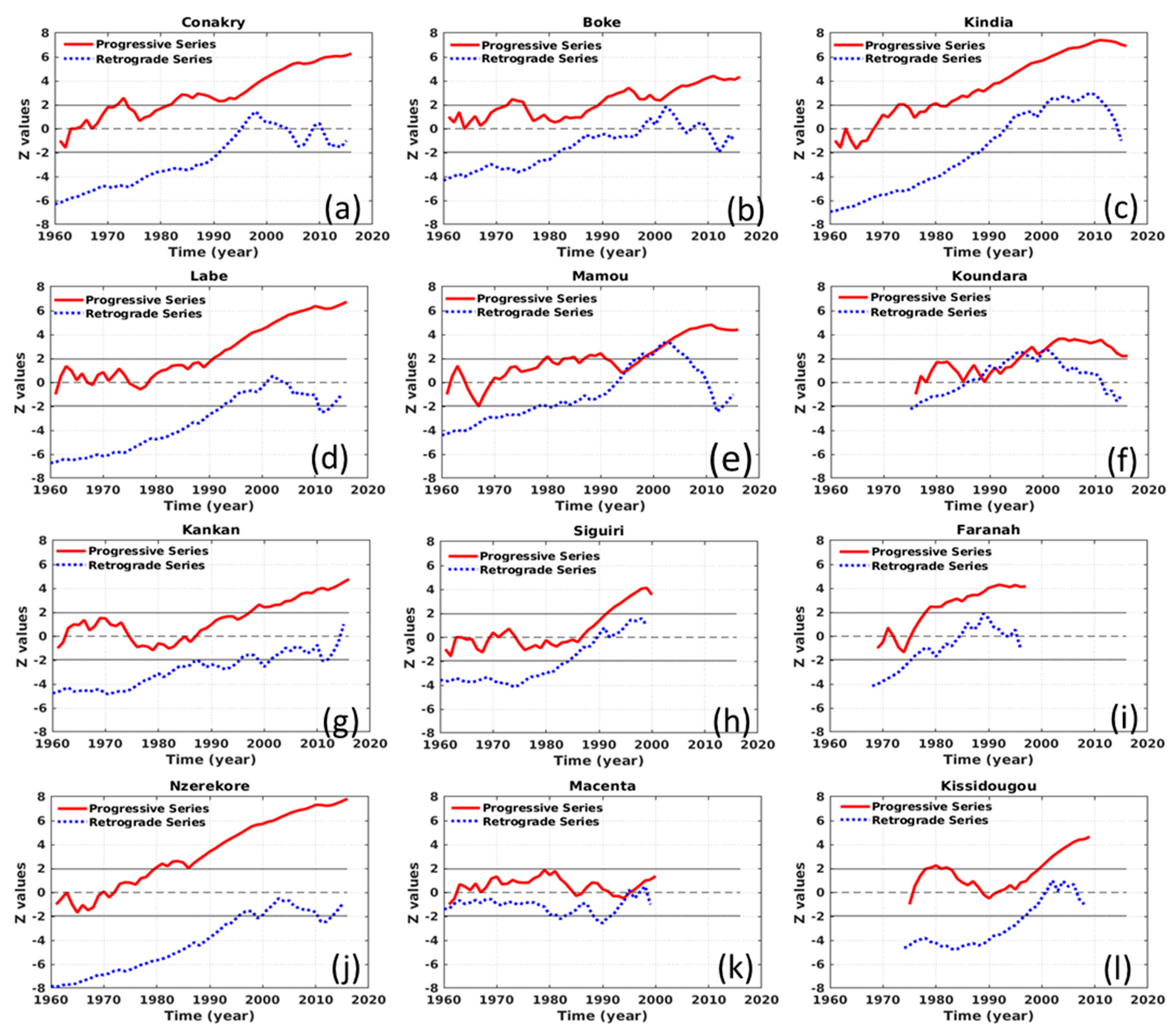
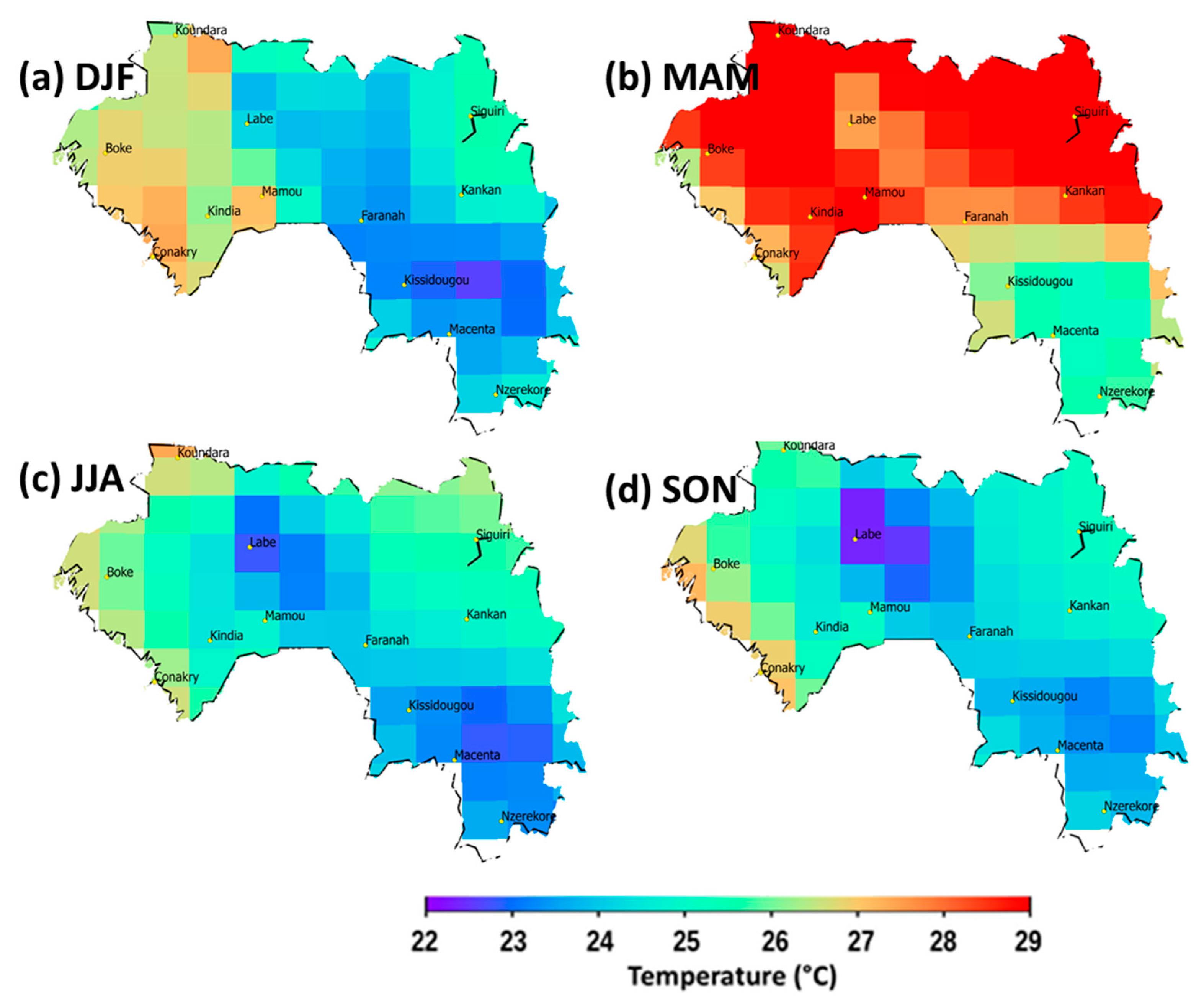

| Station | Long (°) | Lat (°) | Alt (m) | Starting Year | Ending Year | Available Data (monthly/year) |
|---|---|---|---|---|---|---|
| Lower-Guinea: lowland area, very watered and high temperatures because of mountains, urban and coastal effects. | ||||||
| Conakry | −13.37 | 9.34 | 46 | 1960 | 2016 | 684/57 |
| Boke | −14.18 | 10.56 | 69 | 1960 | 2016 | 684/57 |
| Kindia | −12.86 | 10.04 | 458 | 1960 | 2016 | 684/57 |
| Middle-Guinea: mountainous area, both lower temperature (Labe and Mamou) and higher temperature (Koundara). | ||||||
| Labe | −12.29 | 11.19 | 1050 | 1960 | 2016 | 684/57 |
| Mamou | −10.08 | 10.38 | 782 | 1960 | 2016 | 684/57 |
| Koundara | −13.31 | 12.34 | 90 | 1975 | 2016 | 504/42 |
| Upper-Guinea: Upland area, high temperatures and lower rainfall. | ||||||
| Kankan | −9.55 | 10.12 | 376 | 1960 | 2016 | 684/57 |
| Siguiri | −9.37 | 11.74 | 361 | 1960 | 2000 | 492/41 |
| Faranah | −10.8 | 10.26 | 358 | 1968 | 1997 | 360/30 |
| Forest Guinea: Forest and mountainous region; very watered with longest length; more rivers. | ||||||
| N’zerekore | −8.83 | 7.75 | 467 | 1960 | 2016 | 684/57 |
| Macenta | −9.28 | 8.32 | 542 | 1960 | 2000 | 492/41 |
| Kissidougou | −10.11 | 9.19 | 524 | 1974 | 2009 | 432/36 |
| Station | AO (%) | SAO (%) | TNA (%) | NIñO 3.4 (%) | AN (%) | SSN (%) | R2 | trend (°C/dec) |
|---|---|---|---|---|---|---|---|---|
| CKY | 32.15 ± 0.31 | 27.69 ± 0.29 | 2.85 ± 0.09 | 0.16 ± 0.02 | 0.88 ± 0.01 | 0.05 ± 0.05 | 0.69 | 0.14 |
| BOK | 70.32 ± 0.27 | 15.05 ± 0.19 | 0.39 ± 0.01 | 0.03 ± 0.01 | 0.63 ± 0.01 | 0.00 ± 0.04 | 0.89 | 0.14 |
| KIND | 51.19 ± 0.31 | 25.88 ± 0.14 | 0.14 ± 0.02 | 0.07 ± 0.01 | 1.02 ± 0.00 | 0.06 ± 0.03 | 0.82 | 0.07 |
| LAB | 56.10 ± 0.28 | 27.32 ± 0.20 | 1.23 ± 0.04 | 0.10 ± 0.01 | 0.16 ± 0.00 | 0.00 ± 0.01 | 0.88 | 0.12 |
| MAM | 50.81 ± 0.25 | 20.68 ± 0.16 | 0.40 ± 0.02 | 0.56 ± 0.03 | 0.22 ± 0.00 | 0.00 ± 0.02 | 0.81 | 0.06 |
| KDR | 66.38 ± 0.23 | 20.28 ± 0.12 | 0.14 ± 0.01 | 0.14 ± 0.01 | 0.14 ± 0.01 | 0.07 ± 0.01 | 0.87 | 0.13 |
| KKN | 11.48 ± 0.09 | 47.60 ± 0.18 | 1.43 ± 0.00 | 16.15 ± 0.11 | 0.01 ± 0.00 | 0.10 ± 0.00 | 0.87 | 0.09 |
| SIG | 10.68 ± 0.11 | 40.83 ± 0.22 | 5.16 ± 0.00 | 23.10 ± 0.16 | 0.21 ± 0.00 | 0.25 ± 0.00 | 0.90 | 0.17 |
| FNH | 48.22 ± 0.46 | 28.20 ± 0.34 | 0.02 ± 0.01 | 2.20 ± 0.10 | 0.23 ± 0.05 | 0.42 ± 0.03 | 0.79 | 0.11 |
| NZR | 23.20 ± 0.26 | 28.24 ± 0.29 | 1.35 ± 0.06 | 0.53 ± 0.04 | 0.69 ± 0.01 | 0.01 ± 0.05 | 0.60 | 0.21 |
| MCT | 38.44 ± 0.52 | 27.91 ± 0.44 | 2.41 ± 0.12 | 1.41 ± 0.10 | 0.84 ± 0.03 | 0.12 ± 0.07 | 0.72 | 0.04 |
| KISS | 34.22 ± 0.38 | 30.99 ± 0.37 | 0.95 ± 0.06 | 0.19 ± 0.03 | 0.24 ± 0.01 | 0.02 ± 0.03 | 0.69 | 0.13 |
| STATION | LONG (°) | LAT (°) | N | P-VALUES | Z-SCORES | MK TEST CONCLUSION |
|---|---|---|---|---|---|---|
| Lower-Guinea | ||||||
| CONAKRY | −13.37 | 9.34 | 57 | 2.40 × 10−1 | 9.45 | Sign. upward trend |
| BOKE | −14.18 | 10.56 | 57 | 4.90 × 10−5 | 4.05 | -//- |
| KINDIA | −12.86 | 10.04 | 57 | 1.17 × 10−7 | 5.29 | -//- |
| Middle-Guinea | ||||||
| LABE | −12.29 | 11.19 | 57 | 5.50 × 10−8 | 5.43 | -//- |
| MAMOU | −10.08 | 10.38 | 57 | 1.15 × 10−1 | 1.57 | Nonsign. upward trend |
| KOUNDARA | −13.31 | 12.34 | 42 | 0.02705 | 2.21 | Sign. upward trend |
| Upper-Guinea | ||||||
| KANKAN | −9.55 | 10.12 | 57 | 1.83 × 10−4 | 3.74 | -//- |
| SIGUIRI | −9.37 | 11.74 | 41 | 4.03 × 10−4 | 3.54 | -//- |
| FARANAH | −10.8 | 10.26 | 30 | 3.49 × 10−5 | 4.14 | -//- |
| Forest Guinea | ||||||
| N’ZEREKORE | −8.83 | 7.75 | 57 | 2.20 × 10−16 | 11.26 | -//- |
| MACENTA | −9.28 | 8.32 | 41 | 0.1706 | 1.4 | Nonsign. upward trend |
| KISSIDOUGOU | −10.11 | 9.19 | 36 | 3.41 × 10−6 | 4.36 | Sign. upward trend |
© 2020 by the authors. Licensee MDPI, Basel, Switzerland. This article is an open access article distributed under the terms and conditions of the Creative Commons Attribution (CC BY) license (http://creativecommons.org/licenses/by/4.0/).
Share and Cite
Loua, R.T.; Bencherif, H.; Bègue, N.; Mbatha, N.; Portafaix, T.; Hauchecorne, A.; Sivakumar, V.; Bamba, Z. Surface Temperature Trend Estimation over 12 Sites in Guinea Using 57 Years of Ground-Based Data. Climate 2020, 8, 68. https://doi.org/10.3390/cli8060068
Loua RT, Bencherif H, Bègue N, Mbatha N, Portafaix T, Hauchecorne A, Sivakumar V, Bamba Z. Surface Temperature Trend Estimation over 12 Sites in Guinea Using 57 Years of Ground-Based Data. Climate. 2020; 8(6):68. https://doi.org/10.3390/cli8060068
Chicago/Turabian StyleLoua, René Tato, Hassan Bencherif, Nelson Bègue, Nkanyiso Mbatha, Thierry Portafaix, Alain Hauchecorne, Venkataraman Sivakumar, and Zoumana Bamba. 2020. "Surface Temperature Trend Estimation over 12 Sites in Guinea Using 57 Years of Ground-Based Data" Climate 8, no. 6: 68. https://doi.org/10.3390/cli8060068
APA StyleLoua, R. T., Bencherif, H., Bègue, N., Mbatha, N., Portafaix, T., Hauchecorne, A., Sivakumar, V., & Bamba, Z. (2020). Surface Temperature Trend Estimation over 12 Sites in Guinea Using 57 Years of Ground-Based Data. Climate, 8(6), 68. https://doi.org/10.3390/cli8060068







